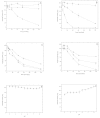Bioprocess and biotecnology: effect of xylanase from Aspergillus niger and Aspergillus flavus on pulp biobleaching and enzyme production using agroindustrial residues as substract
- PMID: 24010038
- PMCID: PMC3755788
- DOI: 10.1186/2193-1801-2-380
Bioprocess and biotecnology: effect of xylanase from Aspergillus niger and Aspergillus flavus on pulp biobleaching and enzyme production using agroindustrial residues as substract
Abstract
This study compares two xylanases produced by filamentous fungi such as A. niger and A. flavus using agroindustrial residues as substract and evaluated the effect of these enzymes on cellulose pulp biobleaching process. Wheat bran was the best carbon source for xylanase production by A. niger and A. flavus. The production of xylanase was 18 and 21% higher on wheat bran when we compare the xylanase production with xylan. At 50°C, the xylanase of A. niger retained over 85% activity with 2 h of incubation, and A. flavus had a half-life of more than 75 minutes. At 55°C, the xylanase produced by A. niger showed more stable than from A. flavus showing a half-life of more than 45 minutes. The xylanase activity of A. niger and A. flavus were somehow protected in the presence of glycerol 5% when compared to the control (without additives). On the biobleaching assay it was observed that the xylanase from A. flavus was more effective in comparison to A. niger. The kappa efficiency corresponded to 36.32 and 25.93, respectively. That is important to emphasize that the cellulase activity was either analyzed and significant levels were not detected, which explain why the viscosity was not significantly modified.
Keywords: Agroindustrial residues; Aspergillus flavus; Aspergillus niger; Biobleaching; Wheat bran.
Figures

Similar articles
-
Production of xylanase by Aspergilli using alternative carbon sources: application of the crude extract on cellulose pulp biobleaching.J Ind Microbiol Biotechnol. 2009 Jan;36(1):149-55. doi: 10.1007/s10295-008-0482-y. Epub 2008 Oct 15. J Ind Microbiol Biotechnol. 2009. PMID: 18923855
-
Xylanases from Aspergillus niger, Aspergillus niveus and Aspergillus ochraceus produced under solid-state fermentation and their application in cellulose pulp bleaching.Bioprocess Biosyst Eng. 2009 Oct;32(6):819-24. doi: 10.1007/s00449-009-0308-y. Epub 2009 Mar 7. Bioprocess Biosyst Eng. 2009. PMID: 19271244
-
Optimization of xylanase production from Aspergillus niger for biobleaching of eucalyptus pulp.Biosci Biotechnol Biochem. 2011;75(6):1129-34. doi: 10.1271/bbb.110032. Epub 2011 Jun 13. Biosci Biotechnol Biochem. 2011. PMID: 21670524
-
Biocatalytic activity of Aspergillus niger xylanase in paper pulp biobleaching.3 Biotech. 2016 Dec;6(2):165. doi: 10.1007/s13205-016-0480-0. Epub 2016 Aug 11. 3 Biotech. 2016. PMID: 28330237 Free PMC article.
-
Production and properties of xylanases from Aspergillus terricola Marchal and Aspergillus ochraceus and their use in cellulose pulp bleaching.Bioprocess Biosyst Eng. 2010 Sep;33(7):813-21. doi: 10.1007/s00449-009-0403-0. Epub 2009 Dec 20. Bioprocess Biosyst Eng. 2010. PMID: 20091051
Cited by
-
Optimization of Xylanase Production from Aspergillus foetidus in Soybean Residue.Enzyme Res. 2018 Apr 11;2018:6597017. doi: 10.1155/2018/6597017. eCollection 2018. Enzyme Res. 2018. PMID: 29850226 Free PMC article.
-
A unique fungal strain collection from Vietnam characterized for high performance degraders of bioecological important biopolymers and lipids.PLoS One. 2018 Aug 30;13(8):e0202695. doi: 10.1371/journal.pone.0202695. eCollection 2018. PLoS One. 2018. PMID: 30161149 Free PMC article.
-
Kinetics of cellulase-free endo xylanase hyper-synthesis by Aspergillus Niger using wheat bran as a potential solid substrate.BMC Biotechnol. 2024 Sep 27;24(1):69. doi: 10.1186/s12896-024-00895-w. BMC Biotechnol. 2024. PMID: 39334195 Free PMC article.
-
Enhanced production of xylanase by Fusarium sp. BVKT R2 and evaluation of its biomass saccharification efficiency.3 Biotech. 2017 Oct;7(5):351. doi: 10.1007/s13205-017-0977-1. Epub 2017 Sep 26. 3 Biotech. 2017. PMID: 28955648 Free PMC article.
-
Gene Expression and Molecular Characterization of a Xylanase from Chicken Cecum Metagenome.Int J Microbiol. 2017;2017:4018398. doi: 10.1155/2017/4018398. Epub 2017 Jul 2. Int J Microbiol. 2017. PMID: 28751915 Free PMC article.
References
-
- Betini JHA, Michelin M, Peixoto-Nogueira SC, Jorge JA, Terenzi HF, Polizeli MLTM. Xylanases from Aspergillus niger, Aspergillus niveus and Aspergillus ochraceus produced under solid-state fermentation and their application in cellulose pulp bleaching. Bioprocess Biosyst Eng. 2009;32(6):819–824. doi: 10.1007/s00449-009-0308-y. - DOI - PubMed
-
- Chapla D, Divecha J, Madamwar D, Shah A. Utilization of agro-industrial waste for xylanase production by Aspergillus foetidus MTCC 4898 under solid state fermentation and its application in saccharification. Biochem Eng J. 2010;49:361–369. doi: 10.1016/j.bej.2010.01.012. - DOI
LinkOut - more resources
Full Text Sources
Other Literature Sources

